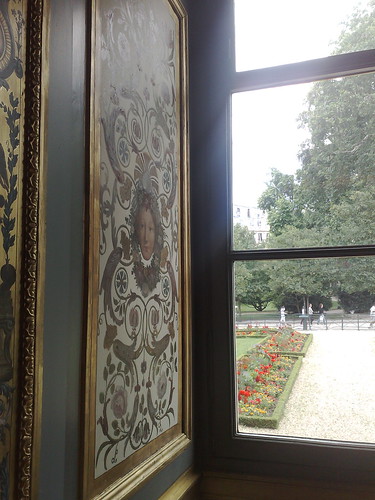Ages ago, I promised a write up of my trip round the Senat. I hadn't forgotten, dear readers (all 3 of you) who are obviously hanging on my every word.
That said, my trip round the Senat was now several weeks ago, and I've lost the handy thingy they gave out at the end with information. So, this may be a slightly more skant version of the blog post I had been intending to write. I know this disappoints you. I'm sorry. (Or, I would be sorry, but I've just come back from holiday, so I don't actually care. But I can pretend, just for you. Yes, I will share the photos and write that up too - maybe even this very evening, if you're lucky. You probably won't be.)
Anyway, the Senat. It's the upper chamber of the French legislature. There are... 340? members. (Their website tells me 343 - I think I was close enough.) And they have the job of scrutinising legislation passed by the lower house, the Assemblee Nationale, and amending it if they think it necessary. Any amendments have to be agreed by the Assemblee Nationale, and, when both houses are in agreement, it goes to the President to sign. (He can't actually refuse, though he technically has the power to do so, I think. What he can do if he hates it is sign it into law, but not implement it - not set an activation date, if you will.)
This is much the same as the process in the UK, for those of you interested - the big practical difference between the Senat and the House of Lords is that the Senat has a clock which limits the amount of time each person is allowed to speak. The Senator proposing amendments can speak for 3 minutes; each person after that has 5 minutes each to put their point across. And there's a big digital red clock counting down as they talk.
The other difference is that the Minister in the Senat doesn't have to actually explain *why* s/he disagrees with the proposed amendments - s/he can just say "I think that's a bad idea." or "Disagree" and sit down. Those of you who have seen debates in the UK Parliament will know that this does not happen there. These both sound like excellent ideas to me, and ones that should be adopted forthwith!
The building (The Palais de Luxembourg) used to belong to Marie de Medici who had it built in 1615 as a modest country home for herself and her son, Louis XIII. It was variously occupied by counts and other important people (Napoleon took it as his residence when he was First Consul of France), and during the War, it served as the headquarters for the Luftwaffe. (There are, I should add, more useful details than my scattered memory can provide on Wikipedia.)
And now, the pretty bits. Photos from the tour, mostly uncaptioned because I couldn't remember what they were if I tried...
Picture on the ceiling
These pictures are painted on leather, if I remember rightly...
Napoleon's throne:
This is the same pattern as you will see on the underneath of the Arc de Triomphe, and is reflected in the carpet on the stairs at the Senat (taken in groups of 4 steps - it's very clever...)
You, too, can go on tours round the Senat - you can certainly go and listen to them debating law if you're so inclined, by handing in your ID at reception and going and sitting very, very quietly in the visitors' gallery. The Senat website has more details on visits if you're interested, and it has a virtual tour, too.













No comments:
Post a Comment